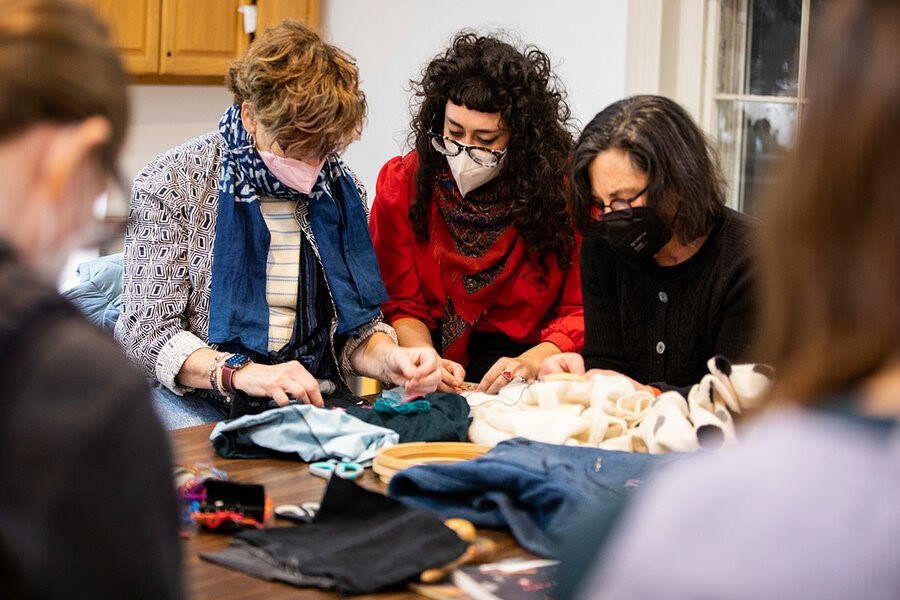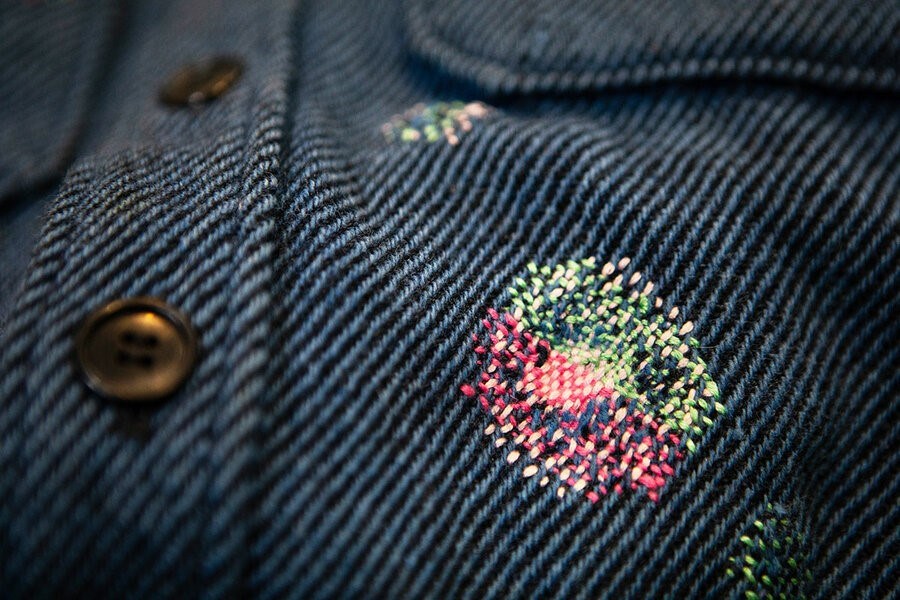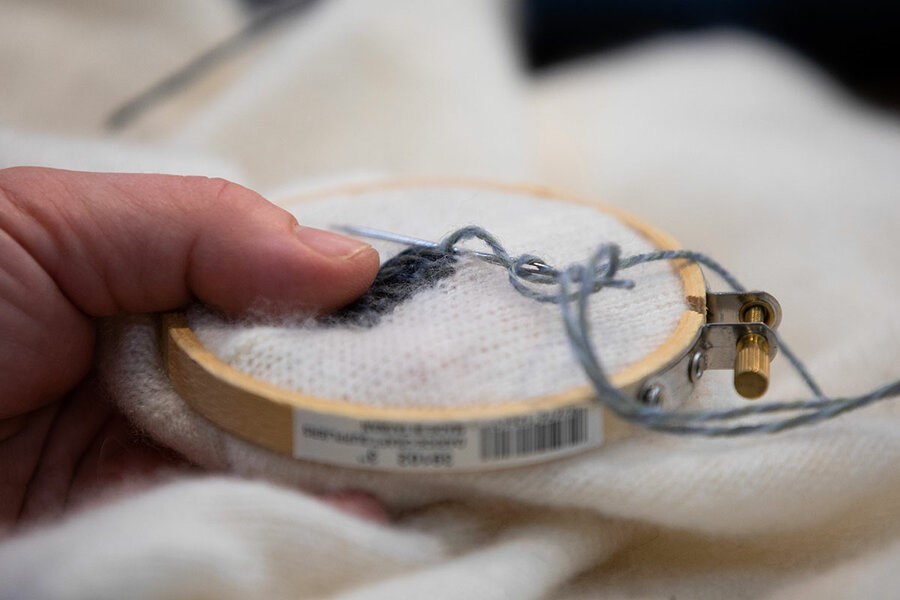REPRINTED WITH PERMISSION FROM THE CHRISTIAN SCIENCE MONITOR
 Textile artist and fashion designer Jessamy Kilcollins (center, in red) teaches a class called "Mending by Hand: Visible Stitching" at the Eliot School of Fine and Applied Arts, on Jan. 18, 2023, in Boston. Participants learn how to mend holes in an artistic way. Melanie Stetson Freeman/Staff
Textile artist and fashion designer Jessamy Kilcollins (center, in red) teaches a class called "Mending by Hand: Visible Stitching" at the Eliot School of Fine and Applied Arts, on Jan. 18, 2023, in Boston. Participants learn how to mend holes in an artistic way. Melanie Stetson Freeman/Staff
March 3, 2023
A giant brown table in the center of a room that smells faintly of paint and worn pine is strewn with colorful yarn. Students ranging from recent college graduates to retired professionals are perched on stools around it, needles poised, eyes fastened on their instructor dressed in bright red.
“Can you do that again?” one asks.
Jessamy Kilcollins teaches darning at the Eliot School of Fine and Applied Arts in the Boston neighborhood of Jamaica Plain. She holds up a snip of denim and a needle threaded with yarn to demonstrate her stitch. Mending, a way of repairing clothing and other textiles that was once the realm of seamstresses and Depression-era grandmas, is back in vogue. The students on this recent evening have brought items they want to not only breathe new life into but also keep out of landfills – sweaters with holes in the elbows, a thrifted pillow, a favorite pair of leggings worn from too many hours on the pickleball court.
“Where have you been all my life?” asks overall-clad Jen Zehler, laughing as she threads her needle, ready to fortify a hole in her leggings.
The evening classroom provides a glimpse into a “slow fashion” trend that is catching on across the United States. Fixing your favorite clothes isn’t just practical and sustainable, its adherents say. It’s also enjoyable and an antidote to tech-laden and sped-up lives. And in Massachusetts, it’s become a necessity. In the fall of 2021, the Bay State released its final 2030 Solid Waste Master Plan with a goal of reducing waste statewide by 30%. On Nov. 1, 2022, Massachusetts issued a ban on throwing textiles in the trash, in what officials have said is the first time a state has implemented such a measure.
 Melanie Stetson Freeman/StaffIn the “Mending by Hand: Visible Stitching” class in Boston, attendees use colorful thread to repair their garments.
Melanie Stetson Freeman/StaffIn the “Mending by Hand: Visible Stitching” class in Boston, attendees use colorful thread to repair their garments.
Toni Columbo, a professional weaver in Boston, has witnessed an influx of customers wanting their clothes mended in the past few years especially as environmental awareness grows. Ms. Columbo, who has been mending for over four decades, started Invisible Reweaving in 1981 with her mother and sisters.
“Fast fashion is made out of plastics. It’s easy and cheap to manufacture. But when it comes time to dispose of those materials, it’s difficult. It doesn’t degenerate into the soil. It’s like a trash bag,” says Ms. Columbo, who mainly works on repairing natural fibers such as wool. She had not heard of the Massachusetts ban until the Monitor asked her about it. “Natural fibers are better for the environment, but they are more expensive,” she adds. But the investment is worth it, she says.
“With slow fashion, these are pieces that people can have their whole lives. Unlike fast fashion where you wear it and throw it away, slow fashion are timeless pieces,” says Ms. Columbo. She says she “would hope” the ban makes a difference.
“Satisfaction” from repair
In the U.S., only 15% of textiles are recycled. A number of states and cities have launched initiatives to change that figure. In New York, Re-Clothe NY and Green Tree Textiles work to inform consumers about the locations of textile recycle bins and what can be recycled there. California recently enacted a law piloting a new system for industrial textile recycling, which includes educating the community about the impacts of fast fashion and establishing accessible recycling sites. Companies like Patagonia and Madewell encourage customers to send in their worn clothes to receive store credit or cash when they are resold.
“The speed of the fashion cycle is very closely aligned to the really key question in fashion and sustainability, which is around volume,” says Kate Fletcher, a professor at the Royal Danish Academy in Copenhagen who coined the term “slow fashion” in 2007. “At the moment we’re engaging in a cycle of gross overconsumption and gross overproduction. If you can slow the speed down, you can begin to reduce the overall volume and this sense of churn.”
 Melanie Stetson Freeman/StaffAn attendee mends a moth hole in a sweater during the “Mending by Hand: Visible Stitching” class.
Melanie Stetson Freeman/StaffAn attendee mends a moth hole in a sweater during the “Mending by Hand: Visible Stitching” class.
Every year, around 100 billion pieces of clothing are produced, and an estimated 92 million tons end up in landfills (11.3 million tons in the U.S. alone as of 2018). The World Economic Forum in 2021 identified fashion as the world’s third-largest polluter, with global research suggesting the industry’s annual greenhouse gas emissions range from 2% to 10% and are growing.
At first, “thrifting,” shopping for secondhand clothes, became a trendy answer to fast fashion, especially among environmentally aware Generation Z and millennial shoppers who had an eye for unique and well-made clothing of previous decades. But as the popularity of thrifting has grown, so have its prices. Enter mending. Instead of throwing textiles away, slow-fashionistas aim to extend the life of clothing and transform perceptions around textiles in the process.
“Studies have shown that people get the same sense of satisfaction or engagement from shopping for new things, as you do when you’re maintaining and repairing the things you already have,” says Dr. Fletcher.
In Grosse Pointe, Michigan, Angie Hoffman, a project manager for Ford Motor Company, says it was her experience working in retail – observing the constant consumer desire for more new clothes – that turned her away from shopping toward the creative pursuits of knitting, sewing, and mending.
When her sister first taught her to knit, Ms. Hoffman thought it was ridiculous to buy yarn to make socks when you could easily purchase a dozen tube socks for $6. But now she finds a lot of satisfaction in knitting while watching TV, or mending a hole in a sock or sewing patches on her favorite sweaters on an evening in.
“I’ve made 23 pairs of socks by hand. It truly is the joy of making something beautiful and having that come from your two hands,” says Ms. Hoffman. “That joy of conquering something new is really satisfying to me.”
 Melanie Stetson Freeman/StaffEmbroidery thread and needles are ready for use in the class in Boston.
Melanie Stetson Freeman/StaffEmbroidery thread and needles are ready for use in the class in Boston.
A practice tech “can’t replace”
Ms. Kilcollins, who started teaching at the Eliot School in 2022, first became aware of the environmental impact of textiles while attending school to earn her certificate in fashion design. She took a sustainable fashion course, which inspired her to start mending and making her own clothes. She co-owns a vintage shop with her husband in Somerville, Massachusetts.
“Especially right now, there is a lot of eco-anxiety and a lot of people [are] becoming more aware of the impacts that our choices have on the environment,” says the textile artist. “People are interested in learning skills to help counteract that.”
Others are interested in “acquiring these skills that they saw their mothers and grandmothers have but that they didn’t pass on to them,” she adds.
Mending student Ms. Zehler says she is enjoying learning an old practice in addition to having an opportunity to bring her together with other people in her community, a nice balance after several years of Zoom meetings and remote work.
“There’s something I’m really enjoying about revitalizing clothes and a practice that ... my ancestors did,” says Ms. Zehler. “There’s also something about sitting together in a circle and learning together. I feel like it’s a sacred ritual, something to be a part of that feels very ancient and old that modern technology can’t replace.”
Related stories
Page created on 3/8/2023 9:49:48 AM
Last edited 3/8/2023 10:05:04 AM
